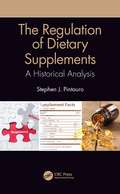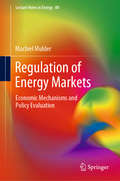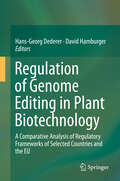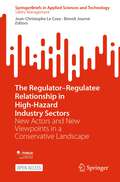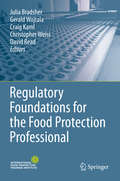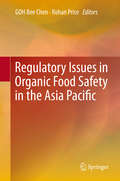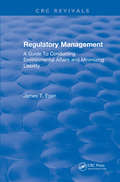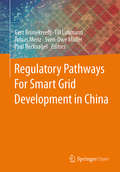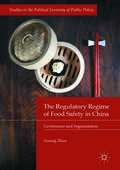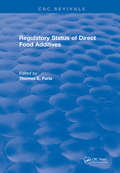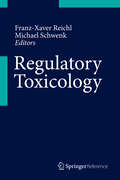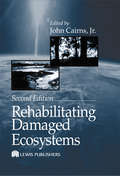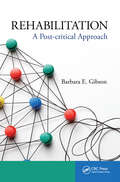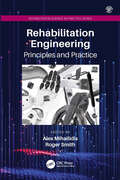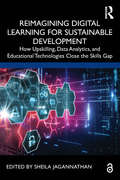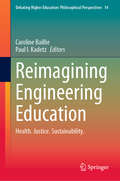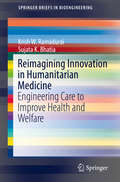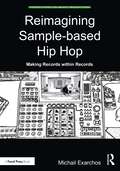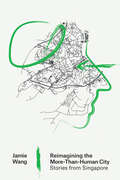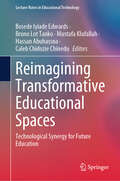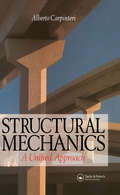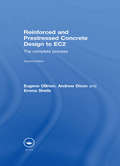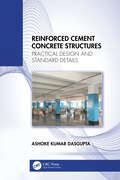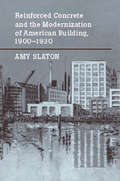- Table View
- List View
The Regulation of Dietary Supplements: A Historical Analysis
by Stephen J. PintauroThis book documents the long, still ongoing battle between the US Food and Drug Administration and the dietary supplement industry. It presents the complex, often subtle, and sometimes overlooked series of events that had a major impact on how dietary supplements are manufactured, marketed, sold, and used today. While the first few chapters focus on some background topics, the remaining chapters walk the reader through timeline of events, legislative actions, FDA proposed and final rules, and judicial decisions that led to our current dietary supplement regulatory framework. Interwoven in narrative are examples of the roles of science, social and public policy, politics, and popular media.
Regulation of Energy Markets: Economic Mechanisms and Policy Evaluation (Lecture Notes in Energy #80)
by Machiel MulderThis textbook explains the main economic mechanisms behind energy markets and assesses how governments can implement policies to improve how these markets function. Adopting a micro-economic perspective, the book systematically analyses the various types of market failures on the electricity and gas markets as well as coal, oil, hydrogen and heat markets to identify government policies that can improve welfare. These shortcomings include the natural monopoly and the public-good character of energy infrastructures; market power resulting from inflexibility of supply and demand; international trade restrictions; negative externalities concerning the use of fossil energy; positive externalities concerning innovative new energy technologies; information asymmetries with regard to the product characteristics of energy commodities; and other public concerns, such as energy poverty. In turn, readers will learn about various measures that governments can use to address these market failures, including incentive regulation for electricity grids; international integration of wholesale energy markets; environmental regulatory measures like emissions trading schemes; subsidy schemes for new technologies; green-energy certificate schemes; and energy taxes. Given its scope, the book will appeal to upper-undergraduate and graduate students from various disciplines who want to learn more about the economics and regulation of energy systems and markets.
Regulation of Genome Editing in Plant Biotechnology: A Comparative Analysis of Regulatory Frameworks of Selected Countries and the EU
by Hans-Georg Dederer David HamburgerThis book provides in-depth insights into the regulatory frameworks of five countries and the EU concerning the regulation of genome edited plants. The country reports form the basis for a comparative analysis of the various national regulations governing genetically modified organisms (GMOs) in general and genome edited plants in particular, as well as the underlying regulatory approaches.The reports, which focus on the regulatory status quo of genome edited plants in Argentina, Australia, Canada, the EU, Japan and the USA, were written by distinguished experts following a uniform structure. On this basis, the legal frameworks are compared in order to foster a rational assessment of which approaches could be drawn upon to adjust, or to completely realign, the current EU regime for GMOs. In addition, a separate chapter identifies potential best practices for the regulation of plants derived from genome editing.
The Regulator–Regulatee Relationship in High-Hazard Industry Sectors: New Actors and New Viewpoints in a Conservative Landscape (SpringerBriefs in Applied Sciences and Technology)
by Jean-Christophe Le Coze Benoît JournéThis open access book addresses relationships that develop from the complex set of legislative, regulatory, and institutional arrangements that arise in the governance of high-hazard industries, especially those connected with safety. It analyses the difference in practices between high-hazard sectors such as nuclear power, chemical processing, and transport with those in the finance and healthcare sectors. The relationship between regulating and regulated entities is important in ensuring that safety is not subordinated to other concerns and in maintaining public confidence. As a result, the brief addresses various pressures and trade-offs inherent in that relationship, trade-offs between such considerations as: cost of the oversight activity and its effectiveness; regulator independence and its level of competency and understanding of the risks involved; ability to provide advice on meeting regulatory goals and being able to criticize decisions made; and effectiveness and intrusion in operational activities. The contributors show how, over time, a more horizontal or “decentred” approach to regulatory oversight has appeared, with a larger degree of delegation of certain decisions to industry and a greater role for a range of third parties such as certification bodies, auditors, insurers, industry associations and NGOs. This book is of interest to academics working in the fields of safety science or organizational management and to practitioners, regulators and policy-makers concerned with health and safety and critical infrastructure.
Regulatory Foundations for the Food Protection Professional
by Julia Bradsher Gerald Wojtala Craig Kaml Christopher Weiss David ReadRegulatory Foundations for the Food Protection Professional is a comprehensive guide for the entry-level food protection professional (FPP) working in either the public or private sector. The book can also serve as a foundation for students in academic programs preparing for a career in food protection. Additionally, as the Food Safety Modernization Act (FSMA) is implemented, this book will provide valuable information for countries wishing to export foods and food ingredients to the U. S. and comply with U. S. food safety regulations. The book is based on the Entry-Level component of the National Curriculum Framework for regulators, created by the International Food Protection Training Institute (IFPTI) located in Battle Creek, Michigan. The Entry-Level component of the National Curriculum Framework contains more than twenty content areas, including Epidemiology, Microbiology, Labeling, Food Defense Awareness, Program Standards, Environmental Health and Safety, Sampling, and Allergens. Each chapter is divided into specific learning objectives aimed at equipping the entry-level FPP with the knowledge and skills necessary to successfully perform his or her job, whether in the public or private sector, and whether in food safety or food defense. Established in 2009, IFPTI is improving public health by building competency-based training and certification systems, and cultivating leadership for the food protection community worldwide. Our mission is to enhance public health by improving the protection of the world's food supply through training, certification, thought leadership, and technology. See more at www. ifpti. org.
Regulatory Issues in Organic Food Safety in the Asia Pacific
by Goh Bee Chen Rohan PriceThe book seeks to address the intersection of food organics and the emergence of a new contractualism between producers, distributors and consumers, and between nation states. Additionally, it seeks to cater to the needs of a discerning public concerned about how its own country aims to meet their demands for organic food quality and safety, as well as how they will benefit from integration in the standard-setting processes increasingly occurring regionally and internationally. This edited volume brings together expert scholars and practitioners and draws on their respective insights and experiences in the field of organics, food and health safety. The book is organized in three parts. Part I outlines certain international perspectives; Part II reflects upon relevant histories and influences and finally, Part III examines the organic food regulatory regime of various jurisdictions in the Asia Pacific.
The Regulatory Landscape in the EU for Dairy Products Derived from Precision Fermentation: An Analysis on the Example of Cheese (SpringerBriefs in Law)
by Federica Ronchetti Laura Springer Kai P. PurnhagenThis book assesses the EU legal framework applicable to dairy products obtained through precision fermentation. It maps the authorisation and labelling requirements for these products to be placed on the EU market. It compares these provisions to those governing the food markets in the USA and Singapore, which are considered to be more innovation-friendly. At the time of writing, the precision-fermented dairy sector is still in the developmental phase, with only a few precision-fermented dairy alternatives available on the market, none of which are present in the EU. Regulatory uncertainty has been cited as significant obstacle for food business operators seeking to introduce alternative protein products in the EU. The book confirms these reports, as the current EU regulatory framework presents several legal uncertainties that are challenging for food business operators to overcome. Broadly speaking, there are two authorisation frameworks applicable to dairy products obtained through precision fermentation in the EU. The choice between these frameworks depends on the presence of genetically modified organisms (GMOs) or residues thereof in the final product. If such GMOs or residues are present, the pre-market authorisation procedure is governed by the Genetically Modified Food and Feed Regulation (GMFR). If the final product does not contain any GMOs or residues, it falls under the scope of the Novel Food Regulation (NFR), and the pre-market authorisation procedure is governed accordingly. Both of these authorisation pathways entail high regulatory requirements, which can pose challenges for the development of the precision fermentation sector. Despite the difficulty in accurately classifying products, it is crucial for food business operators to comprehend the applicable legal framework early in the product development process, given that the authorisation paths differ in their standards. In addition to pre-market authorisation requirements, companies must address labelling issues. Food labelling shall provide a basis for consumers to make informed choices in relation to the foods they consume. The primary objective of EU food labelling law is to prevent consumer deception , making it crucial for dairy products and their animal-free alternatives, to adhere to a stringent naming law as stipulated in the Common Market Organisation and specific accompanying legislation. Moreover, it is imperative to consider regulations regarding the use of health and nutrition claims, as well as labels such as “vegan” or “organic”, etc. Furthermore, the labelling of novel foods and genetically modified foods may necessitate mandatory information specified in the authorisation process. The book serves as a comprehensive guideline for food business operators involved in the production of precision-fermented dairy alternatives, aiding them in navigating the intricate European regulatory landscape.
Regulatory Management: A Guide To Conducting Environmental Affairs and Minimizing Liability
by James T. EganRegulatory Management: A Guide to Conducting Environmental Affairs and Minimizing Liability emphasizes the importance of establishing a proactive approach to permit negotiation and compliance. This book is an important guide to conducting environmental affairs and minimizing liability. This book is a "must have" book for anyone responsible for regulatory compliance/management - private industry, environmental consultants, university officials, environmental engineers, environmental attorneys.Public and political concern about the environment has grown at a phenomenal rate over the last several years. Not since the early 1970s has there been such emphasis on reducing pollution. Congress and the Environmental Protection Agency have responded by enacting tough new legislation and increasing enforcement activities. Industry, utilities, and other entities that continue to discharge must invest millions of dollars in advanced waste treatment or face heavy fines or liability.In 10 detailed chapters, the author explains how to establish cooperative partnerships with politicians and regulators, create solution-oriented strategies using legal and technical permit insights, allocate resources to provide maximum environmental protection at minimum cost, reduce accidents and errors through training programs and procedure documentation, and influence the regulatory process to win practical and achievable permit limits. The book also shows you how to increase public credibility and manage the media, track treatment operations to provide a strong defense in the event of litigation, and keep up with new regulations and new technologies. The book is designed to help its readers set into motion the processes that will develop real solutions to environmental/regulatory challenges and will assist in developing an active and proactive management style that focuses on results as it minimizes liability.
Regulatory Pathways For Smart Grid Development in China
by Gert Brunekreeft Till Luhmann Tobias Menz Sven-Uwe Müller Paul RecknagelThe study's recommendations describe institutional elements in the context of electric power sector regulation and has the objective to increase the understanding of the interdependencies of the institutional elements. In future work, the study results might be employed for designing very specific regulatory policies. The recommendations developed in this study focus primarily on the regulatory framework for smart grids and contains a quite detailed description of how the German electricity markets evolved. It also focuses on the effects of ambitiously expanding generation capacities of renewable energy sources (RES) on established electricity markets. The presented evidence will provide insights on how the regulatory framework in China could be designed to foster smart grids developments in the context of establishing electricity markets and expanding RES generation capacities.
The Regulatory Regime of Food Safety in China
by Guanqi ZhouThis book examines the decade from 2004 to 2013 during which people in China witnessed both a skyrocketing number of food safety crises, and aggregating regulatory initiatives attempting to control these crises. Multiple cycles of "crisis - regulatory efforts" indicated the systemic failure of this food safety regime. The book explains this failure in the "social foundations" for the regulatory governance of food safety. It locates the proximate causes in the regulatory segmentation, which is supported by the differential impacts of the food regulatory regime on various consumer groups. The approach of regulatory segmentation does not only explain the failure of the food safety regime by digging out its social foundation, but is also crucial to the understanding of the regulatory state in China.
Regulatory Status Of Direct Food Additives
by Thomas E. FuriaThe primary purpose of this volume is to provide readers with quick summaries of and references to the current U.S. government and other regulations for some of the most frequently employed direct food additives. Indirect additives, such as pesticide residues, packaging adhesives, polymeric coatings, and animal feed chemicals, have not been included.
Regulatory Toxicology
by Franz-Xaver Reichl Michael SchwenkThis book will be written by experts for professionals, scientists and all those involved in toxicological data generation and decision-making. It is the updated and expanded version of a monograph published in German in 2004. Chemical safety is regulated on various levels including production, storage, transport, handling, disposal or labelling. This book deals comprehensively with the safety-ensuring methods and concepts employed by regulatory agencies, industry and academics. Toxicologists use experimental and scientific approaches for data collection, e. g. about chemical hazards, physicochemical features or toxicokinetics. The respective experimental methods are described in the book. Toxicologists also deal with much insecurity in the exposure and effect scenarios during risk assessment. To overcome these, they have different extrapolation methods and estimation procedures at their disposal. The book describes these methods in an accessible manner. Differing concepts from one regulation area to another are also covered. Reasons and consequences become evident when reading the book. Altogether, the book Regulatory Toxicology will serve as an excellent reference. "
Rehabilitating Damaged Ecosystems
by John Cairns Jr.Built on a strong foundation in restoration ecology, this unique handbook provides practitioners, academics, and managers with vital tools needed to plan for ecosystem conservation, to restore degraded ecosystems, to make cost-effective restoration decisions, and to understand important legal issues. Rehabilitation of Damaged Ecosystems, Second Edition boasts three completely new chapters and five major chapter revisions. Coastal wetlands restoration, watershed rehabilitation and management, mined land reclamation, revegetation of disturbed ecosystems, and river and stream restoration are only a few of the critical topics explored in this timely reference handbook.This Second Edition provides valuable, reliable data as well as practical methods and techniques for the ongoing fight to protect natural resources and restore damaged ecosystems.
Rehabilitation: A Post-critical Approach (Rehabilitation Science In Practice Series)
by Barbara GibsonRehabilitation is dedicated to helping people not only survive, but also thrive. Despite this complex goal, the organizing principles of rehabilitation still rely on biomedicine to construct disability as a problem of impaired bodies. Rehabilitation professionals are committed to helping to enhance people's lives, but many struggle with how to do s
Rehabilitation Engineering: Principles and Practice (Rehabilitation Science in Practice Series)
by Alex Mihailidis and Roger SmithThis book will provide an overview of the rehabilitation engineering field, including key concepts that are required to provide a solid foundation about the discipline. It will present these concepts through a mix of basic and applied knowledge from rehabilitation engineering research and practice. It's written as an introductory text in order to provide access to the field by those without previous experience or background in the field.These concepts will include those related to engineering and health that are necessary to understand the application of rehabilitation engineering to support human function.
Reimagining Digital Learning for Sustainable Development: How Upskilling, Data Analytics, and Educational Technologies Close the Skills Gap
by Sheila JagannathanReimagining Digital Learning for Sustainable Development is a comprehensive playbook for education leaders, policy makers, and other key stakeholders leading the modernization of learning and development in their institutions as they build a high value knowledge economy and prepare learners for jobs that don't yet exist. Currently, nearly every aspect of human activity, including the ways we absorb and apply learning, is influenced by disruptive digital technologies. The jobs available today are no longer predicators of future employment, and current and future workforce members will need to augment their competencies through a lifetime of continuous upskilling and reskilling to meet the demands of the Fourth Industrial Revolution. This book features curated insights and real-world cases from thought leaders throughout the world and identifies major shifts in content formats, pedagogic approaches, technology frameworks, user and design experiences, and learner roles and expectations that will reshape our institutions, including those in emerging economies. The agile, lean, and cost-effective strategies proposed here will function in scalable and flexible bandwidth environments, enabling education leaders and practitioners to transform brick-and-mortar learning organizations into digital and blended ecosystems and to achieve the United Nation’s ambitious Sustainable Development Goals by 2030.
Reimagining Engineering Education: Health. Justice. Sustainability. (Debating Higher Education: Philosophical Perspectives #14)
by Caroline Baillie Paul I. KadetzThis book considers a radical change to engineering education. It argues for a reexamination of the traditional way in which engineering students are educated in disciplinary silos and how, instead, we might re-imagine their professional education to more appropriately prepare students to design innovative solutions to increasingly complex global challenges. It poses the question: “How can engineers think outside the engineers’ box?". A box that has over generations rendered engineers to be unquestioning servants of the socio-political systems in which they function. The book introduces a unique framework and language for engineering education which considers both the problems of the past and present, and the potential solutions offered for the future. By reaching out beyond the bounds of traditional knowledge and thought collectives, this book will also offer a pathway for other professional education programs to explore.
Reimagining Innovation in Humanitarian Medicine: Engineering Care to Improve Health and Welfare (SpringerBriefs in Bioengineering)
by Krish W. Ramadurai Sujata K. BhatiaThroughout history, humanity has been plagued by a myriad of humanitarian crises that seemingly take the form of perpetual human suffering. Today, approximately 125,000,000 people require humanitarian assistance as the result of famine, war, geopolitical conflict, and natural disasters. A core component of this suffering is afflictions related to human health, where disturbances strain or overwhelm the existing healthcare infrastructure to create the conditions for an increase in morbidities and co-morbidities. One of the more startling elements is the loss of life to preventable medical conditions that were not properly treated or even diagnosed in the field, and is often due to the limited interventional capacity that medical teams and humanitarian practitioners have in these scenarios. These individuals are often hindered by medical equipment deficiencies or devices not meant to function in austere conditions. The development of highly versatile, feasible, and cost-effective medical devices and technologies that can be deployed in the field is essential to enhancing medical care in unconventional settings. In this book we examine the nature of the creative problem-solving paradigm, and dissect the intersection of frugal, disruptive, open, and reverse innovation processes in advancing humanitarian medicine. Specifically, we examine the feasible deployment of these devices and technologies in unconventional environments not only by humanitarian aid and disaster relief agencies, but also by crisis-affected communities themselves. The challenge is complex, but the financial support and technical development of innovative solutions for the delivery of humanitarian aid is a process in which everyone is a stakeholder.
Reimagining Sample-based Hip Hop: Making Records within Records (Perspectives on Music Production)
by Michail ExarchosReimagining Sample-based Hip Hop: Making Records within Records presents the poetics of hip-hop record production and the significance of sample material in record making, providing analysis of key releases in hip-hop discography and interviews with experts from the world of Hip Hop and beyond. Beginning with the history of hip-hop music making, this book guides the reader through the alternative techniques deployed by beat-makers to avoid the use of copyrighted samples and concludes with a consideration of the future of Hip Hop, alongside a companion album that has been created using findings from this research. Challenging previous theoretical understandings about Hip Hop, the author focuses on deconstructing sonic phenomena using his hands-on engineering expertise and in-depth musicological knowledge about record production. With a significant emphasis on both practice and theory, Reimagining Sample-based Hip Hop will be of interest to advanced undergraduates, postgraduates, and researchers working in audio engineering, music production, hip-hop studies, and musicology.
Reimagining the More-Than-Human City: Stories from Singapore (Urban and Industrial Environments)
by Jamie WangAn exploration of the multifaceted urban environmental issues in Singapore through a more-than-human lens, calling for new ways to think of and story cities.As climate change accelerates and urbanization intensifies, our need for more sustainable and livable cities has never been more urgent. Yet, the imaginary of a flourishing urban ecofuture is often driven by a specific version of sustainability that is tied to both high-tech futurism and persistent economic growth. What kinds of sustainable futures are we calling forth, and at what and whose expense? In Reimagining the More-Than-Human City, Jamie Wang attempts to answer these questions by critically examining the sociocultural, political, ethical, and affective facets of human-environment dynamics in the urban nexus, with a geographic focus on Singapore.Widely considered a model for the future of urbanism and an emblematic new world city, Singapore, Wang contends, is a fascinating site to explore how modernist sustainable urbanism is imagined and put into practice. Drawing on field research, this book explores distinct and intrarelated urban imaginaries situated in various sites, from the futuristic, authoritarian Supertree Grove, positioned as a technologically sustainable solution to a velocity-charged and singular urban transportation system, to highly protected nature reserves and to the cemeteries, where graves and memories continue to be exhumed and erased to make way for development. Wang also attends to more contingent yet hopeful alternatives that aim to reconfigure current urban approaches. In the face of growing enthusiasm for building high-tech, sustainable, and &“natural&” cities, Wang ultimately argues that urban imaginings must create space for a more relational understanding of urban environments.
Reimagining Transformative Educational Spaces: Technological Synergy for Future Education (Lecture Notes in Educational Technology)
by Bosede Iyiade Edwards Bruno Lot Tanko Mustafa Klufallah Hassan Abuhassna Caleb Chidozie ChineduThis book explores the symbiotic relationship between human learning and machine learning, examining how emerging technologies and human–machine interfaces are reshaping the educational landscape. Organized into four sections with 20 chapters, it provides a multidisciplinary perspective on the dynamic intersection of these twin concepts. Bridging theory and practical implementation, the book goes beyond theoretical foundations, offering actionable strategies for educators, policymakers, and institutions to harness the transformative power of technology enhanced learning. This book showcases the impact of these innovations on human learning and machine learning, which is particularly relevant for developing and transition nations. Enriched with case studies, empirical research, and data-driven insights, it serves as a comprehensive guide for understanding and navigating the evolving landscape where human learning and machine learning converge.
Reinforced and Prestressed Concrete: Incorporation Bs 8110 And Microcomputer Applications
by F. K. Kong R. H. EvansThis highly successful textbook has been comprehensively revised for two main reasons: to bring the book up-to-date and make it compatible with BS8110 1985; and to take into account the increasing use made of microcomputers in civil engineering. An important new chapter on microcomputer applications has been added.
Reinforced and Prestressed Concrete Design to EC2: The Complete Process, Second Edition
by Eugene Obrien Andrew Dixon Emma SheilsConcrete is an integral part of twenty-first century structural engineering, and an understanding of how to analyze and design concrete structures is a vital part of training as a structural engineer. With Eurocode legislation increasingly replacing British Standards, it’s also important to know how this affects the way you can work with concrete. Newly revised to Eurocode 2, this second edition retains the original’s emphasis on qualitative understanding of the overall behaviour of concrete structures. Now expanded, with a new chapter dedicated to case studies, worked examples, and exercise examples, it is an even more comprehensive guide to conceptual design, analysis, and detailed design of concrete structures.The book provides civil and structural engineering students with complete coverage of the analysis and design of reinforced and prestressed concrete structures. Great emphasis is placed on developing a qualitative understanding of the overall behaviour of structures.
Reinforced Cement Concrete Structures: Practical Design and Standard Details
by null Ashoke Kumar DasguptaThis book aims to provide actual methods of calculation and standard details followed by professionals in industrial projects pertaining to Reinforced Cement Concrete (RCC) structures backed by practical design and standard details. It covers the engineering properties of soil and types of tests, different types of concrete grades, standard notes and codes, and workout examples of piles, foundations and superstructure elements. It provides all of the standard construction details, including reinforcement arrangements, generally used for RCC works in superstructures and foundations.Features: Provides the strength design calculation for foundation and settlement analysis of the founding soil together Discusses standard details of reinforced concrete joints and reinforcement placement Describes suitable types of material and selection of structure according to the nature of the founding soil and service life of the plant Explores standard construction details Includes solved problems, design and workout examples as per Indian and US standards This book is aimed at professionals in construction, structural and civil engineering.
Reinforced Concrete and the Modernization of American Building, 1900-1930 (Johns Hopkins Studies in the History of Technology)
by Amy E. SlatonExamining the proliferation of reinforced-concrete construction in the United States after 1900, historian Amy E. Slaton considers how scientific approaches and occupations displaced traditionally skilled labor. The technology of concrete buildings—little studied by historians of engineering, architecture, or industry—offers a remarkable case study in the modernization of American production.The use of concrete brought to construction the new procedures and priorities of mass production. These included a comprehensive application of science to commercial enterprise and vast redistributions of skills, opportunities, credit, and risk in the workplace. Reinforced concrete also changed the American landscape as building buyers embraced the architectural uniformity and simplicity to which the technology was best suited. Based on a wealth of data that includes university curricula, laboratory and company records, organizational proceedings, blueprints, and promotional materials as well as a rich body of physical evidence such as tools, instruments, building materials, and surviving reinforced-concrete buildings, this book tests the thesis that modern mass production in the United States came about not simply in answer to manufacturers' search for profits, but as a result of a complex of occupational and cultural agendas.
